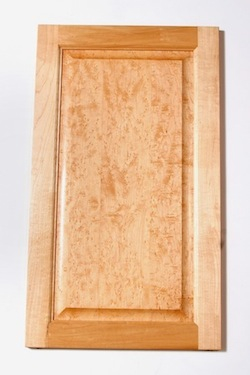
I am about to start staining and finishing my new maple kitchen cabinets. Maple has proved difficult to stain using everyday stains like Minwax® so, after a little research, I realized I was going to have to use a dye stain. I have chosen to use General Finishes water-based dye stain as it is easiest for a novice to use and penetrates the maple well. On my sample pieces, I applied a wood conditioner and lightly sanded. I then applied the stain to the color I wanted. I do not know what my best next step should be. Should I apply a sanding sealer, then sand again, or is that necessary? I have also read that you cannot use sanding sealer under a sprayed precatalyzed spray lacquer, which is what I was thinking of finishing them with. I am concerned with brushing on a final finish because I don’t know if it will cause the water-based dye stain to bleed into the liquid brush-on finish. Will it? Also, can I just use a water-based finish like Deft water-based wood finish instead of the spray lacquer? I just want to be sure and get it right. Any help you can give will be greatly appreciated. – Rebecca Vosburg
Tim Inman: It is just great that you’re asking questions and doing some testing first. Sample boards are your friends! You will not only get a better result using them, but you will also set yourself up to have some fun doing the real job. Jumping in headfirst without testing or learning usually results in headaches and disappointment for all of us.
Maple, one of the really dense woods, does indeed offer interesting staining characteristics. Actually, some refer to it as “blotchy” and others refer to it with more favor. Whatever, it is natural for maple to NOT stain evenly.
I like to “sneak up” on my finishes. I think dye staining is a great first step. However, I’d recommend you try using your stain at about half-strength. With dyes, you can go back later and add more to get a stronger richer color. Dyes are not very forgiving, so test and sample before you launch. After your dye has dried, a light sealer coat would be the next step. I prefer what is called a “wash” of sealer. This simply means you dilute your sealer material a lot. I often use shellac cut to about 10 percent shellac and 90 percent solvent (alcohol) as my sealing wash. Why? It goes on wet, and “restores” the dry dye color. It soaks in, and it scuff sands easily. If I want to add more color, I haven’t clogged up the wood with sealer. You could also use sanding sealer as a wash — just dilute it with the appropriate solvent, which is labeled on the can. Since you will be putting on such a small amount of finish product, once it is completely dry, you should have no compatibility issues with your chosen topcoat.
Now here’s a place you might want to experiment a little more. This additional step is more work, but the results can be fantastic. Oil stains do things to wood that water stains can’t. You can have the best of both. After scuff-sanding your dyed and wash-coat sealed wood, apply a coat of an oil-based wiping stain. This is a stain that contains both dyes and pigments carried in a drying oil base. Your wood will take on a rich, deep look as a result. Try this on a sample board first, but I’ll bet you like the results enough to do it on your whole project. Again, seal with a dilute wash coat. Allow it to dry completely, and scuff sand for smoothness. (Nylon Scotch-Brite™ or steel wool substitute may be all you need for this step.) Complete your finish. Send us pictures!
(Editor’s Note: Tim also noted that the book he’s written, The Art of Classical Furniture Finishing, “covers all this and more.” It is available from Amazon.com or autographed copies are available directly from author Tim Inman at www.historicinteriors.com.)
Chris Marshall: In addition to Tim’s thorough answer, I’ll add only one more side note: You’ll only be in danger of smearing water-based dye if you topcoat it with a finish that contains water as its solvent— such as water-based varnish. Water will redissolve the dye in the wood and could lead to a mess. Once the dye is encapsulated under a seal coat as Tim discusses, any finish (even water-based) should work fine. Or, if you don’t use a sealer over the dye, pick a topcoat with a different solvent base (shellac or oil-based varnishes are safe choices).





